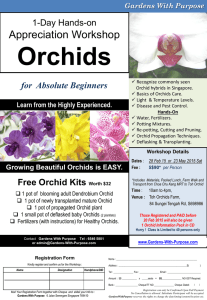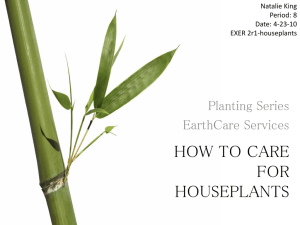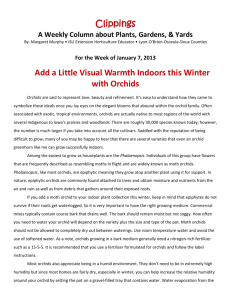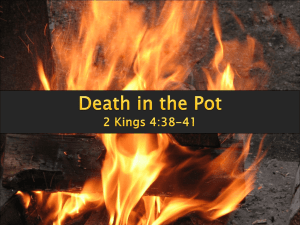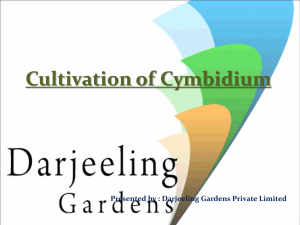Dendrobium
advertisement
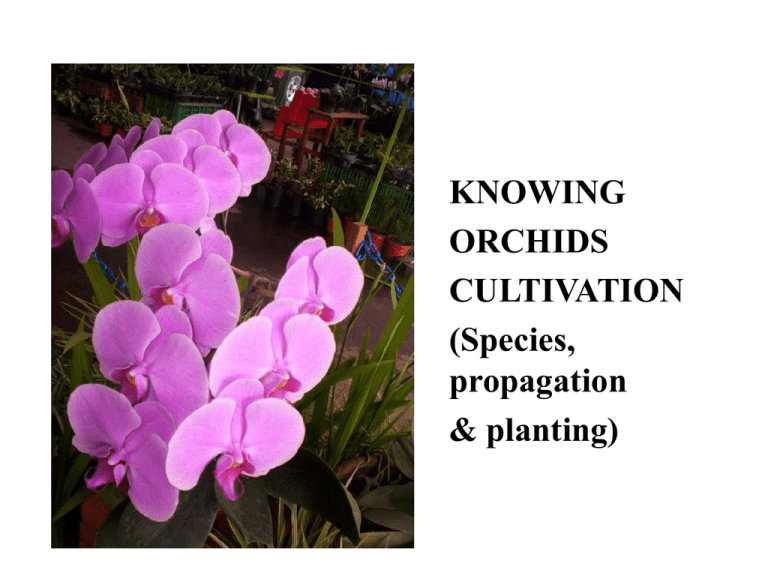
KNOWING ORCHIDS CULTIVATION (Species, propagation & planting) POTENTIAL OF INDONESIAN RESOURCE • Beautiful landscape • Fertile soil • Expected of climate INDONESIA AS A MEGABIODIVERSITY COUNTRY • Indonesia has about 4000 orchids species is distributed in many islands. • Kalimantan & Sumatera have about 986 orchids species and Java has the ones more than 971 species. • Maluku has about 123 species. • Irian jaya has about more than 1000 species (Dendrobium and Bulbophyllum) • Growing at elevations from sea level up to 3000 meters and temperature between up 8,7 °C to 32°C. • They are found on branches of trees at in tropical rain forests. CARACTER OF ORCHIDS DISTRIBUTED • Cosmopolite orchid ; distributing caracter of orchids in whole Indonesian land (Dendrobium crumenatum, Spathoglottis plicata). • Endemic orchid ; distributing caracter of orchids in specific places. Phalaenopsis javanica grows in west Java, Cymbidium hartinahianum is found in North Sumatera, Vanda celebica is found in Sulawesi only. TAXONOMY • • • • • Phyllum Class Subclass Ordo Family : Spermatophyta : Angiospermae : Monocotyledoneae : Gynandrae : Orchidaceae ORCHIDS CARACTERISTIC • Foliage shape • Flower consist of ; - Sepal - Petal - Column - Labellum • Fruits • Seeds FIGURE ORCHID SHAPE CARACTERISTIC OF ORCHIDS GROWS • Epiphyte; type of plant which grows on another but isn’t a parasite & deriver its own nutrients from the air, rain, etc. • Saprophyte; (plant) any organism living on decaying or putrefied matter. • Terrestrial; (plant) living & growing on land • Lithotrof; type of plant which grows above stone. GROWTH STRUCTURE IN ORCHID • Monopodial orchids such as Aerides, Phalaenopsis & Vanda have main stems which grow constantly. • Sympodial orchids, such as Bulbophyllum and Dendrobium have a main stem, or pseudobulb, which is produced annually and matures at the end of each growing season, often culminating with flowering. Simpodial orchid Monopodial orchid ORCHIDS GENUS IN INDONESIA • Such as; DENDROBIUM, BULBOPYLLUM, COELOGYNE, CYMBIDIUM, GRAMMATOPHYLUM, PHALAENOPSIS, RENANTHERA, VANDA, AERIDES, RYNCOSTYLIS, PAPHIOPEDILUM, ERIA. • DENDROBIUM THE GREATES OF GENUS, ABOUT 1800. • ABOUT 900 GENUS ARE FOUND IN INDONESIA Aerides odorata • About 20 species belong to this genus of monopodial epiphytes. • Aerides odorata is variable in colour, from deep pink to pure white. Bulbophyllum biflorum_yellow • Over 2000 named species are included in this cosmopolitan genus, with flowers that come in all shapes, sizes and colour. • Most of these sympodial plants grow and lithophytes as epiphytes. Cymbidium bicolor • Most of the species are terrestrial, with upright flower spikes bearing blooms in many colour. • In the lowlands, most cymbidium take to the trees as epiphytes, growing in high light. Dendrobium • An amazing diversity of plant habit, flower form & colour is found in this large genus. • Quite a number of species produce new plants off the older pseudobulbs. these are called aerials or “keikis” a Hawaiian word which means baby. Phalaenopsis amabilis • Most people would be familiar with Phalaenopsis, known as the “Moth Orchids”. • Many hybrids have been produced from the 50 or so wild species. • Most of these white hybrids have been derived from the magnificent “White Moth Orchid”, Phalaenopsis amabilis. Paphiopedilum • The “Slipper Orchids” have long been highly prized in horticulture. • Some species are terrestrial, growing through the leaf litter on the forest floor, others are lithophytes which show a preference for limestone cliffs, while a number are epiphytes, & live in the major forks of suitable trees. • Most of the species produce a single flower. Vanda tricolor • Vanda tricolor is a distinctive common species, found on rocks or trees on the fringes of lowland forest in Java. • It has perfumed flowers. • Monopodial plants grow and as epiphytes. GROWTH CONDITION • Light, humidity, temperature. • • • • • • • • • Kind of orchids Light absorbtion Arachnis 100 Renathera 100 Vanda daun 40 - 50 Cattleya 20 - 30 Dendrobium 40 - 50 Phalaenopsis 10 - 30 Paphiopedilum daun bintik 10 - 30 Paphiopedilum daun hijau 5 - 20 Aerides 20 - 40 TEMPERATURE Kind of orchids • Cattleya • Cymbidium • Dendrobium • Paphiopedilum • Phalaenopsis • Vanda Normal Temperature (°C) 20 25 25 20 21 30 GENERATIF PROPAGATION • Generatif Pollination male female parent PREPARING INOCULATION CONSIST OF : 1. To provide a prominent seed. 2. To provide bottle, led & autoclve 3. Nutrient and equipment e.1. Knudson C. Bahan Ca (NO3)2H2O KH2PO4 MgSO4 7H2O (NH4)2SO4 Sukrose FeSO4 4H2O MnSO4 Agar-agar Aquadest Kebutuhan (g/l) 1 0,25 0,25 0,25 20 0,25 0,0075 15-17,5 1000 ml pH media Bbrp jenis anggek membutuhkan pH 5,2 Phalaenopsis membutuhkan pH 5,5 e.2. Vacin & Went Bahan Ca3(PO4)2 KH2PO4 MgSO4 7H2O (NH4)2SO4 MnSO4.4H2O KNO3 Fe2(C4H4O6)3 atau Fe-chelate Air kelapa Sukrose Agar-agar Aquadest Kebutuhan (g/l) 0,2 0,25 0,25 0,5 0,0075 0,525 0,028 0,057 150 ml 20 7 850 ml pH media Pada umumnya digunakan pH 5,7-5,8 e.3. Resep Chang Bahan Fish emulsion Pepton Gula pasir Agar-agar Aquadest Kebutuhan (g/l) 1,5 sendok teh 1 sendok the 5,5 15 1000 ml pH media Dendro, Vanda, Arachnis 5-5,2 Phalaenopsis 6,8 How to inoculate ? a. To sterilize into capurite solution, about 10 minutes. b. To remove into aquadest. c. To inoculate into medium (spread) VEGETATIF PROPAGATION BY TISSUE CULTURE • Requirements ; a. Prominent explant b. Appropriate of medium c. Circumtance • Tissue culture rooms consist of; a. Preparation room b. Inoculation room c. Incubation room FIGURE INOCULATION ROOM Sterilization • To keep expant into 20% clorox solution, about 5 minutes, 10 % clorox solution about 5 minutes and to rinse by aquadest. Inoculation • To provide sterile explant with less size and one bud. Incubation and Multiplication • Explant is shaked on 100-200 rpm (shaker) in the long periode, room temperature. • Subculture Removed explant into new medium. PIGURE INCUBATION ROOM ACCLIMATIZATION VEGETATIF PROPAGATION ORCHIDS PLANTING 1. To remove planlet in community pot (in 9-12 months after innoculation). - Dendrobium seedling better to control of light & humidity. - Each pot contains about up 25 to 30 plants. 2. Terrestrial type using medium composition involve; • Sand, soil, brick, manure, compost. 3. Vanda terres, its able to plant into earth. 4. Seedling is planted in large community (pot). 5. Removing explant up community pot to single pot. - How to remove ? - To prepare medium, consist of moss, brick,etc 6. Repotting. Why to repot? - need a larger medium - need much nutrients Figure Single pot • Each pot has one plant which plant after about 4-6 months in community pot. PLANTING (in pot) • Using in high quality pot. • Using stick to strengthen. • Using brick, moss, etc. HOW TO PLANT; - To conbine a stick & pot. - To mix medium composition. (brick) less than half pot. - To put plantlet on above medium. - To add moss later. IT IS IMPORTANT TO NOTE THAT ; • Stem can’t be covered by medium. • Might be planted monopodial type in centre pot. • Different to monopodial, sympodial type need to close part of pot. ORCHID MAINTENANCE • Watering; (to note) - Kind of water and pH level (5,6 – 6,0) - Medium, humidity, temperatur, pot type, species of orchids, phase of growth. • Fertilizer application Pemupukan Umur anggrek Seedling Mid-size Flowering-size • How to apply ? -Spread, by watering, spraying. Kebutuhan unsur N P 60 30 30 30 10 60 K 10 30 10 PLANT PROTECTION BY CONTROLING PEST AND DISEASE • Pest; acarina, red spider, ant. • Insecticide; diazenon, malathion, sumithion 1-3 cc/ liter water. • Disease; leaf spot, soft-rot, physiology disease. • Fungicide; teresan 3 g/ liter water, captan 2 g/ liter water, cuproxychloride 5 g/ liter water.
